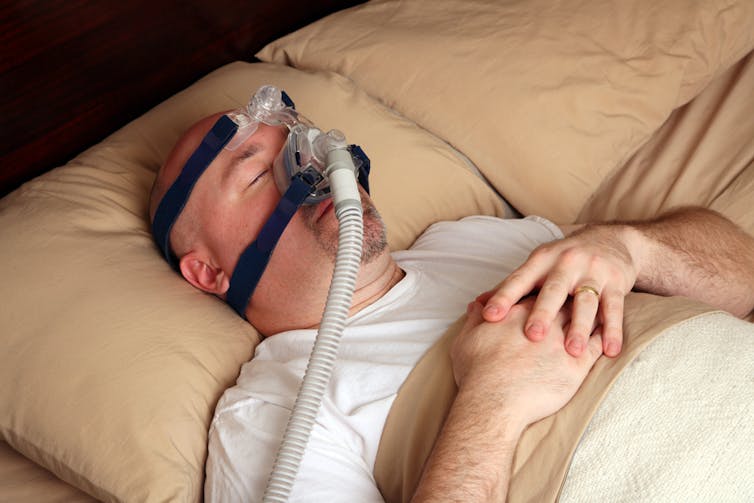Obstructive sleep apnoea (OSA) is a common sleep-related breathing disorder, where the upper airway repeatedly collapses during sleep. During an obstructive breathing event, someone with OSA continues to breathe but cannot get enough air into the lungs because the upper airway becomes too narrow or closes completely (this is known as apnoea).
Although the OSA patient is likely unaware, the airway typically reopens when they awaken from sleep, usually for a period of three to 15 seconds. These intermittent breathing disruptions and arousals, which can occur more than 100 times per hour in severe cases, lead to low oxygen levels (hypoxia) and interrupt sleep continuity.
It’s unclear exactly how many people currently have OSA and we expect many are unaware they have the disorder. The largest American community-based study of the occurrence of OSA conducted in the 1990s found 24% of men and 9% of women were affected. These individuals experienced more than five breathing disruptions per hour of sleep, a level associated with a variety of adverse health outcomes. Similar occurrence rates were reported in Australian males in the mid 1990s.
But given the ever-increasing rates of obesity, a major risk factor for OSA, the current prevalence is likely to be considerably higher.
High economic and health costs
The total economic cost of OSA to the Australian community was estimated at more than $21 billion in 2010. This includes the cost of health care, as well as indirect costs such as accidents, social security payments and lost productivity.
In terms of health costs, untreated OSA is associated with multiple adverse outcomes. As you can imagine, repetitive breathing disruptions can severely affect sleep quality and can lead to excessive daytime sleepiness. Dreaming (rapid eye movement) and deep (slow wave) sleep, both of which are believed to be important for memory and learning, are often disrupted in patients with OSA. Accordingly, impaired brain function can occur.

Patients with OSA are also six- to seven-times more likely to have a motor vehicle accident. Repetitive airway collapse can lead to large pressure fluctuations in the chest and hypoxia which places stress on the heart and cardiovascular system. Consequently, the risk of high blood pressure, stroke and sudden cardiovascular death during sleep is increased in people with OSA, as is diabetes.
Most recently, OSA has been associated with an increased risk of cancer death.
Causes
There are a variety of causes of OSA. Obesity, being male, and getting older are all risk factors. But we’re yet to fully understand how each of these factors actually cause OSA. Indeed, although far less common, young, thin individuals can also have OSA.
What is clear, is that some degree of anatomical vulnerability – having a narrow or a crowded upper airway – combined with an inability of the upper airway muscles to keep the airway open during sleep are characteristic features of OSA.
Other factors such as waking too easily and having an overly active breathing response during sleep can also contribute.
Ultimately, the interaction of the various causes of OSA, the relative contribution of which varies substantially between patients, determines whether or not an individual has OSA and how severe it is.
Treatment
The first-line treatment for OSA, developed by the pioneering work of Professor Colin Sullivan from the University of Sydney in the early 1980s, is continuous positive airway pressure (CPAP). The concept is simple: the patient wears a mask and sufficient air, the amount of which varies between patients, is blown into the mask to prevent airway closure during sleep.

The masks and technology to deliver CPAP have progressed substantially. CPAP is now highly effective in reducing sleep-related breathing disturbances and millions of patients worldwide benefit enormously from CPAP therapy.
But around half of OSA patients are either completely intolerant or only partially compliant with CPAP, leaving many patients incompletely treated or untreated. Secondary treatments, such as mandibular advancement splints (a dental device designed to pull the jaw forward to open the throat area), are beneficial in many cases but tend to be less effective than CPAP.
New advances in sleep apnoea research
Given the burden of disease, its major consequences, the high failure rates of CPAP and the limited number of alternative treatment options, developing novel and effective treatments for OSA is a priority.
Ongoing work aimed at defining the various causes of OSA in individual patients offers hope that it will be possible to tailor novel therapeutic approaches on a per-patient basis.
Finally, while there have been several studies linking untreated OSA with adverse health outcomes (particularly cardiovascular disease) and the potential for CPAP to improve certain cardiovascular parameters, we still don’t have large clinical trials demonstrating that CPAP reduces major cardiovascular events in those who are most at risk.
Several large-scale multi-centre trials are underway around the world aimed at addressing these unresolved issues – the Adelaide Institute for Sleep Health’s Sleep Apnoea Cardiovascular Endpoints (SAVE) study is just one example. This work will be crucial in informing future clinical care of OSA and its consequences.
See more Explainer articles on The Conversation.

